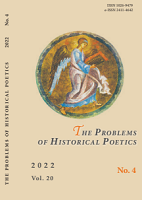Русские рукописные произведения о «неизменяемости судеб Божиих» (сюжет «Марко Богатый»)
Russian Handwritten Works on the “Immutability of the Destinies of God” (the Plot of “Marco the Rich”)
Author(s): Alexander Valerievich PiginSubject(s): Cultural history, Customs / Folklore, Russian Literature, Philology
Published by: Петрозаводский государственный университет
Keywords: handwritten books; folklore tales; the plot of Marko the Rich; poetics of the plot; I. S. Myandin;
Summary/Abstract: The article is devoted to handwritten works of the 17th–19th centuries, in which the global plot known as “Marko the Rich” in Russian materials, is used: a rich man receives a prophecy that his son-in-law and heir will be the son of poor parents; he tries to ruin the boy, but the prediction comes true. The plot was known both in Europe and in the East, it penetrated into Russian literature in the Middle Ages. The focus is on four works: “Example” (Priklad) about the Caesar Conrad and the knight’s son from the “Roman Acts” (Gesta Romanorum), “The Tale of a Rich Merchant,” a short novel without a title from the manuscript codex of the Library of the Russian Academy of Sciences (Arkhangelsk collection, S. No. 138), “The Short Novel About the Rich and the Poor, and How God’s Destinies are Immutable” from the manuscripts of the 19th-century Pechora Old Believer scribe I. S. Myandin. The last two works are being examined for the first time. The article examines the composition and plot of the literary works, as a comparative material, folklore tales about Marko the Rich are used. Literary works differ in origin (“Example” is a translated work, the rest are original), in the time of creation, and in plot development. At the same time, they are all religious works that affirm the idea of the dependence of human fate on God’s providence. Genetic connections between the works are not clearly traced, and the appearance of certain motifs in the texts is explained by the influence of folklore tales.
Journal: Проблемы исторической поэтики
- Issue Year: 20/2022
- Issue No: 4
- Page Range: 42-69
- Page Count: 28
- Language: Russian

